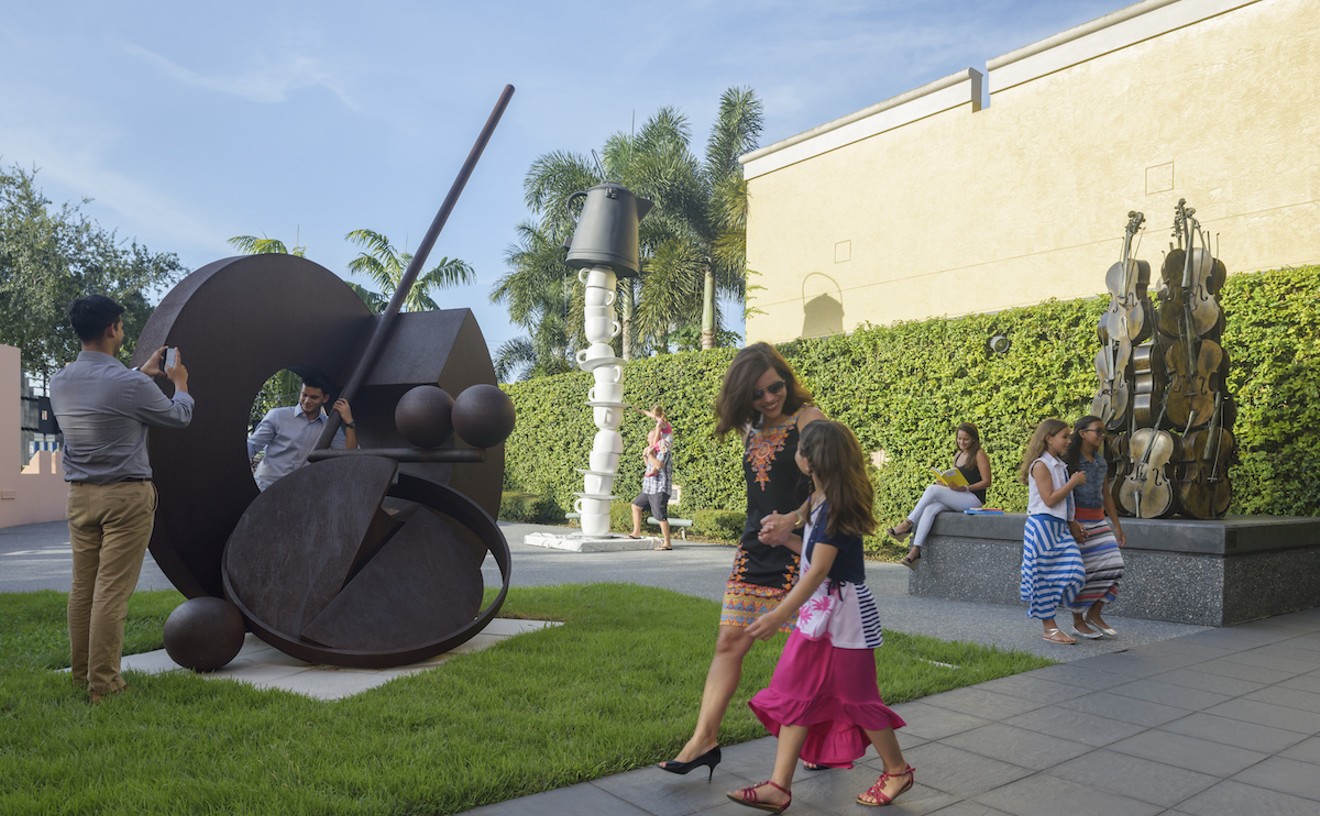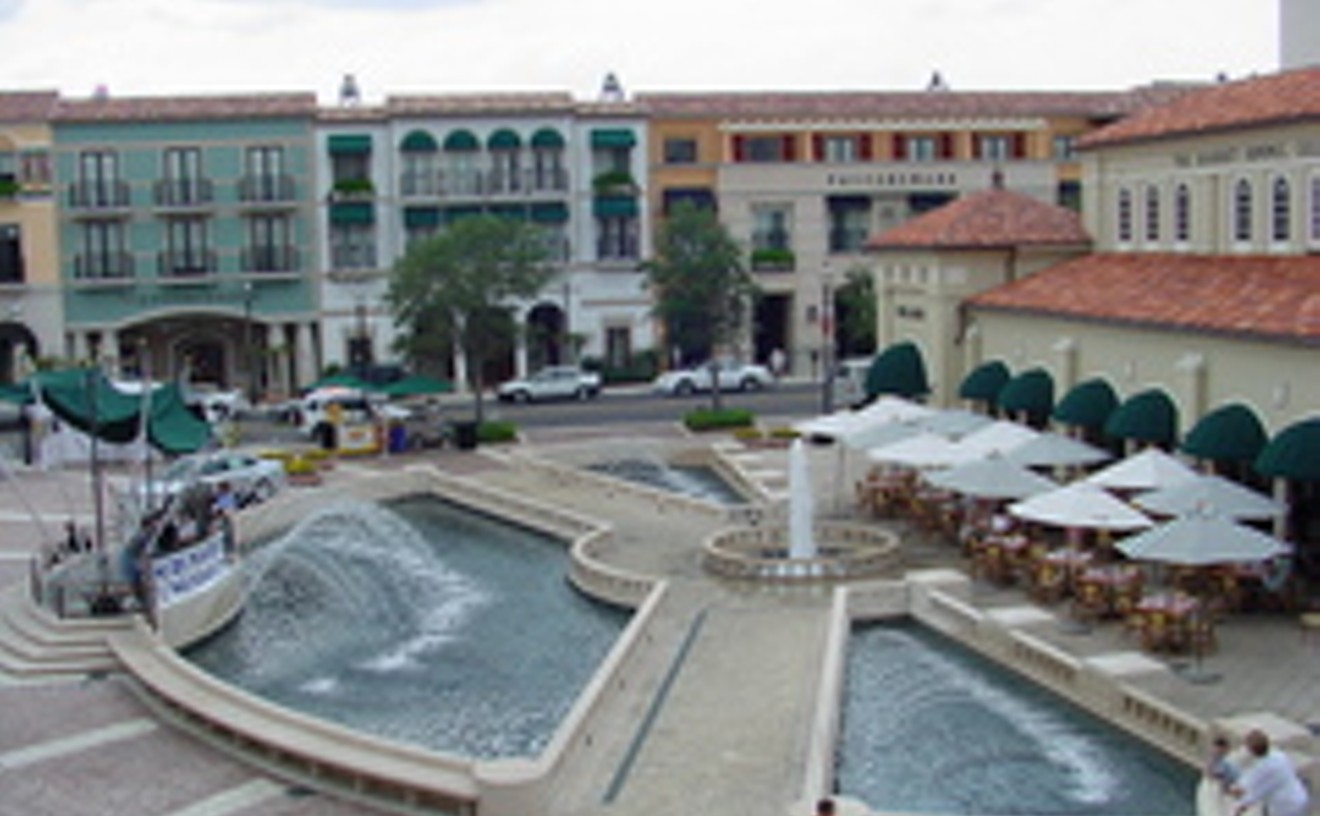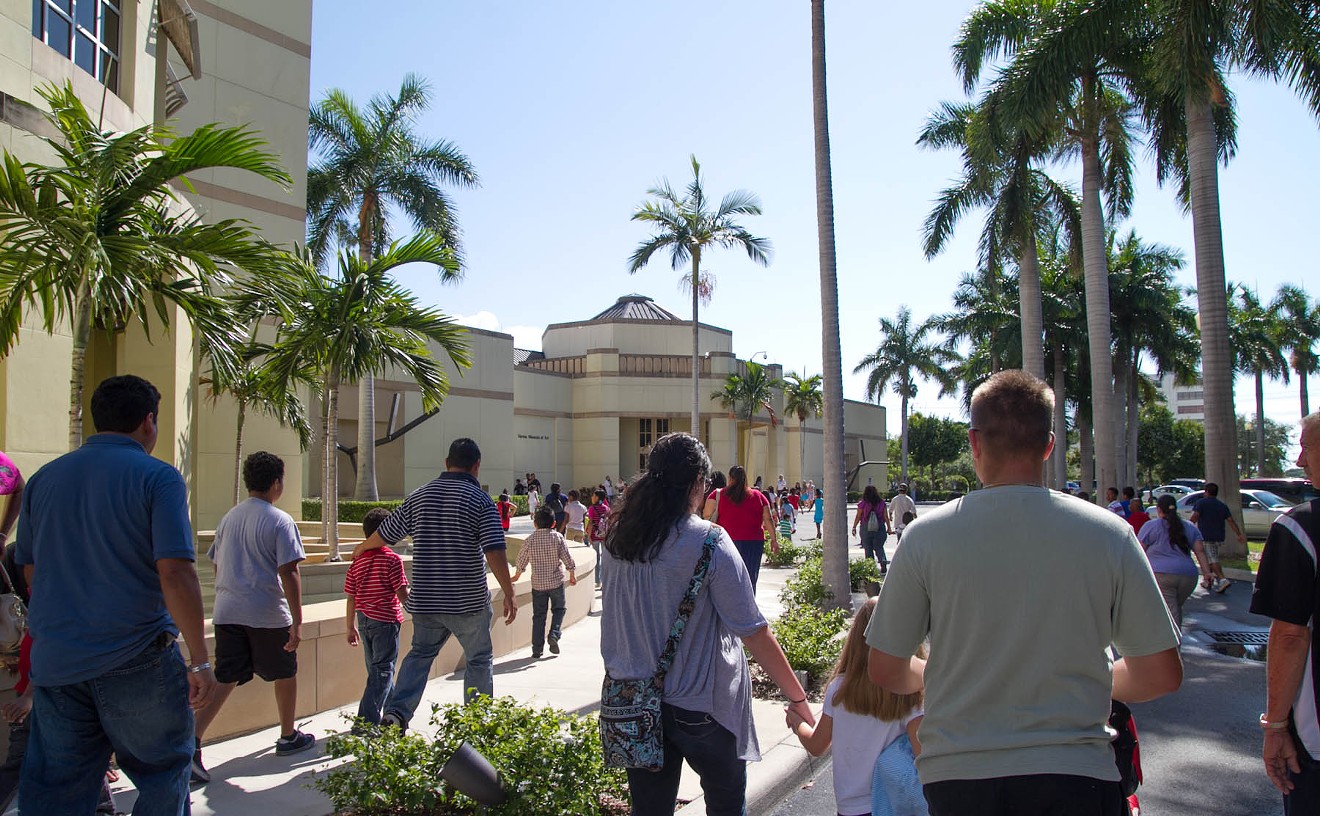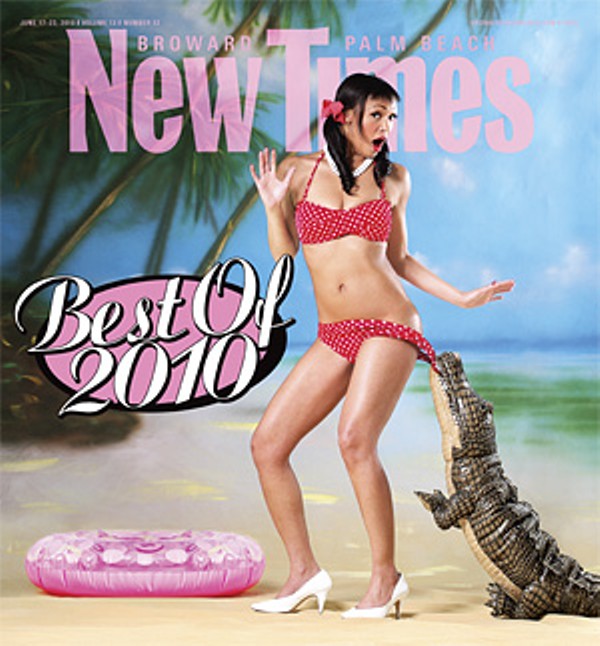Best Live Band
Community Property
Only a hard-working band like Community Property is built to snag two Battle of the Bands victories in one day. On a fateful day in late March, led by ferocious frontman Lucian, this rock and soul quartet ran circles around its competition first at the Seminole Casino's Classic Spring Block Party, then at New Times' own musical brawl. Muscular beyond all else, each Community Property statement tells the crowd "get down with us or get the hell out of the way." Owing bits of its sound to Jimi Hendrix, Red Hot Chili Peppers, and John Belushi's character in The Blues Brothers, the band exudes showmanship that involves executing everything tight as hell and making it look like a gas. Playing a fusion of blues, jazz, funk, and rock 'n' roll is one thing, but flinging oneself across the stage and feeling it is something entirely different.
Best Solo Exhibition
"An Unfinished Conversation: Collecting Enrique Martínez Celaya," Boca Raton Museum of Art

Eduardo Chacon
Just last year, we were welcoming Enrique Martínez Celaya back to South Florida, the artist having decamped from his Delray Beach studio a year earlier and moved back to Los Angeles. But who would have guessed that the itinerant painter, philosopher, photographer, poet, and publisher — he was born in Cuba, grew up in Spain and Puerto Rico, teaches in Colorado and Nebraska, and has shown all over the world — would make a comeback as dramatic as this one-man show? For years, Martínez Celaya has steadily produced some of the most intellectually rigorous art of his generation (he's still in his 40s). With this, his most extensive South Florida exhibition since "The October Cycle" at the Museum of Art|Fort Lauderdale in 2004, he proved he still has few equals. Although the show included only 19 works, the Boca Museum wisely gave it most of the first floor, and the often-monumental pieces commanded the space with grace and authority. The kicker: The works are all from a private collection, that of filmmaker Martin Brest. Envy was never so easy.
- 501 Plaza Real, Boca Raton, 33432 Map
- 561-392-2500
- www.bocamuseum.org
Best Director
J. Barry Lewis, Copenhagen, Palm Beach Dramaworks
Copenhagen is a play about quantum mechanics. At least, it is a play about the way one aspect of quantum mechanics, called "quantum indeterminacy," mirrors our understanding of history. In particular, it's about our understanding of one weird night in 1941 when Nazi scientist Werner Heisenberg visited his old friend, Niels Bohr, to talk about the Nazi plan to build a nuclear weapon. To mount it convincingly, Lewis had to understand a lot about the trickiest aspects of modern science, and he had to conceive of a way to get the point across to audiences who might understand none of it. His production communicated with remarkable cohesion on every level — from the blocking to the acting to the program to the lighting — and became a strange and frightening masterpiece.
- 201 Clematis St., West Palm Beach, 33401 Map
- 561-514-4042
- www.palmbeachdramaworks.org
Best Album
Surfer Blood's Astro Coast
After self-released versions of Astro Coast floated around late last year, Surfer Blood's statement got solid with an official release via Kanine Records in January. Aside from its nationwide acclaim (and inevitable backlash), Astro Coast holds up when viewed through the lens of South Florida's beach-resort culture. "Swim (To Reach the End)" turns JP Pitts' voice into an invigorating hurricane. His commentary on "Catholic Pagans" smacks of the listlessness of living in a region that doesn't always feel so connected to the rest of the country: "Never could be still for long/And I could never hold a job/Coupled with a weakness for cocaine and liquor/Not much you can do for love." Astro Coast turned out to be Surfer Blood's ticket out — and a peek inside what's possible for everyone else.
"Swim" from Surfer Blood's Astro Coast.
Best Metal Band
Murderous Rampage
Rumor has it that the devil grew a third horn after hearing this Fort Lauderdale outfit's song titled "Eating Drinking Shitting." Frontman Tom Rampage, who cultivates a serious following as bartender at the Poor House in downtown Fort Lauderdale (see more on this below), bellows with such force that any mullets within 1,000 feet start flapping uncontrollably. "Fuck you, motherfucker" is rarely screamed with this level of commitment and with such a thrust from the supporting cast of badass players. And if it isn't already clear, we couldn't give this honor to a nicer bunch of guys.
"Programmed to Kill" by Murderous Rampage:
Best Art Gallery
Gallery 721

Where would you turn if you wanted, say, one of the largest selections anywhere of work by the South Florida-based outsider artist Purvis Young? What if you were out to build a collection of posters from every Elvis movie ever made? Who might supply you with autographed Beatles memorabilia or original tickets from Woodstock? Believe it or not, there's a place for one-stop shopping for these and about a million other items, including original works by pop artist Peter Max and folk artist Howard Finster, to name just a couple more. The place in question is Gallery 721, and it comes with a bonus in the form of proprietor Larry Clemons, who will not only sell you a chunk of art or pop culture history but also regale you with the story behind the art object of your choice. Clemons has been operating out of his jam-packed, 6,500-square-foot warehouse of a space by the railroad tracks since 2001, and he's constantly augmenting his enormous inventory. He has the passion of a true collector because he is one, and he'll help you find just the right work of art or artifact to make you feel truly cool.
- 721 Progresso Dr., Fort Lauderdale, 33304 Map
- 954-765-0721
There was an amused look that Marjorie Lowe wore throughout her one-act performance as Anne, the wife of Jerry — a character well-known to fans of the original Albee Play, Zoo Story, of which At Home is an expansion. She was exasperated with Jerry and even went through the motions of fighting with him — but she didn't really fight with him. That look on her face belied it all, and it was a look of love. In almost every line, Lowe did a masterful job of communicating her and Jerry's shared history; the words seemed to take on shades of meaning that only the two of them could understand, because of their long years of practice. Lowe's performance was understated, wise, and extremely lovely.
- 201 Clematis St., West Palm Beach, 33401 Map
- 561-514-4042
- www.palmbeachdramaworks.org
Best Country Band
Boise Bob and His Backyard Band
Hallandale Beach's Boise Bob is twangin' about a revolution. And unlike Toby Keith, this type of rebellion is several states outside of the Nashville system. Not content to let his toe-tapping, old-time swamp music roll past without an impact, Boise Bob has social politics on his mind that will be on yours if you give a listen. The raw edges of this country-fried punk cut through the bull with a track like Kmart ode "Blue Light Special." "Every time the blue light flashes, you will see the white trash dash in," he drawls in a voice straight out of the Appalachian foothills. Lest we forget Darnell Hotdog's banjo-chomping, Tex Merlot's washboard-scraping, and Owen Cash's washtub-bass-slapping, Boise Bob's backup crew, the Backyard Band, isn't afraid of a damned thing either. Even if it doesn't inspire a line dance, this music has no shortage of inspiring ideas.
Best Music Festival
SunFest

SunFest has literally been doing it longer than Lollapalooza, and it's easy to see why. Every spring since 1982, the West Palm Beach waterfront comes alive with a 280,000-strong, music-filled party that's built on solid-enough business practices to keep it going for years to come. The 2010 lineup, which featured genre-busters like Weezer, Nas, Damian Marley, Sean Kingston, the B-52's, and ZZ Top, showed a commitment to snagging credible acts that have proven themselves to be more than a flash in the pan or just a greatest-hits show. The other big success of the festival: It's dirt cheap to attend. While Coachella and Bonnaroo each run well over $200 per ticket, SunFest attendees can settle in for five days of music for about $60. That, and the place never reeks of patchouli.
- Flagler Drive and Clematis St., West Palm Beach, 33401 Map
- 561-659-8007
- www.cityofwpb.com
Best Art Museum
Norton Museum of Art

Since its 1941 opening, the museum has grown dramatically, more than doubling its size with one expansion, completed in 1997, and adding 75 percent more gallery space with another expansion a mere half-dozen years later. The museum now encompasses 122,500 square feet. The collection has grown commensurately, so that it's now up to more than 7,000 works, with substantial holdings in European, American, Chinese, and contemporary art as well as photography. And although a surprising amount of this art is on view at any given time, the Norton doesn't stint on its special rotating exhibitions either. Of the dozen or so from the past year, five were recently on view at the same time, and their diversity is a testament to the institution's creative programming: "Avedon Fashion 1944-2000," "Habsburg Treasures: Renaissance Tapestries From the Kunsthistorisches Museum, Vienna," "Here Comes the Sun: Warhol and Art After 1960 in the Norton Collection," "Paul Fusco: RFK Funeral Train Rediscovered," and "Reclaimed: Paintings From the Collection of Jacques Goudstikker." In the case of an art museum, bigger really is better — it's a matter of having more room for more art, and on both those counts, the Norton wins.
- 1451 S. Olive Ave., West Palm Beach, 33401 Map
- 561-832-5196
- www.norton.org





